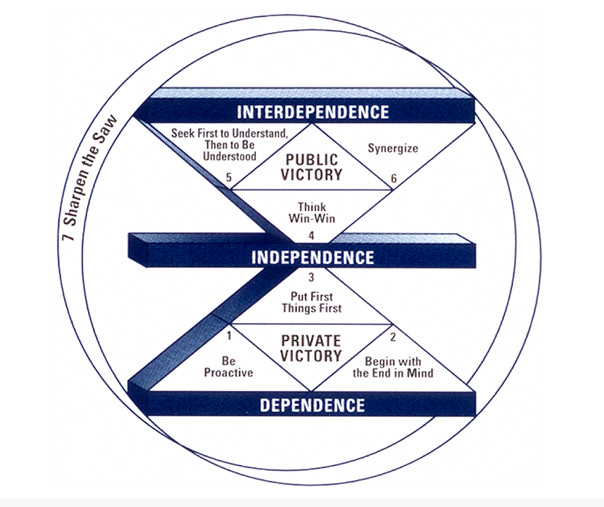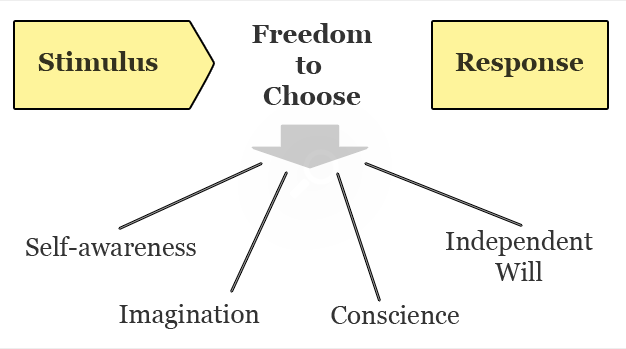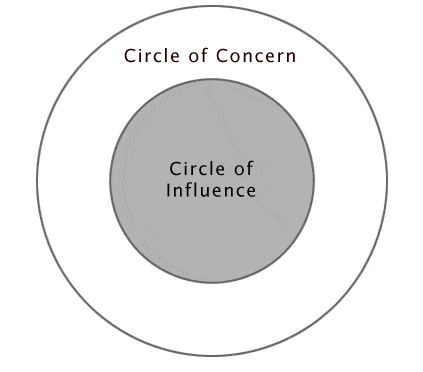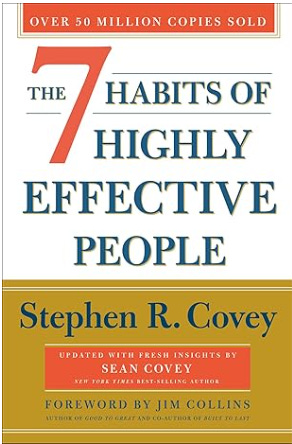Be Proactive — Take The Weather With You
“The first choice we make each and every day is, ‘Will we act upon life, or will we merely be acted upon?” Stephen Covey

There is a lot of overlap between professional development and personal development. To improve your career and to develop your craft, you can focus on the technical skills, like project management, scheduling, cost management, selling ideas and so forth. You can also work on improving yourself, which has an impact on how you do your work and also on your personal life.
One of my colleagues introduced me to Stephen Covey’s book, and it opened my eyes to personal and professional development and was the first step into a lifelong journey of personal development.
This is the first article in a series of articles on the book “Seven Habits of Highly Effective People”. Instead of just rehashing what Stephen Covey wrote, I’ll add in other practices that I have included to develop that habit.
Seven Habits Model
How many times have you screamed at the kids when they did something wrong, or flipped the driver in the next lane for cutting in front of you? I know I have done those things and countless more times. And afterwards, you know what, I feel disappointed in myself.
It's not the things that happen to you that matter, but how you react to them that counts.
Stephen Covey wrote a seminal book called “The 7 Habits of Highly Effective People”. A colleague gave me a copy when we were both in a graduate program at an insurance company. It blew me away and got me on this path of personal development and self-improvement. I’ve read it many times at different stages of my life, and each time I discover something new that helps me move forward.
The first habit, Be Proactive, is one of three that Covey groups in the Private Victory section of his model. By improving your skills in these three habits, you will move towards self-mastery. The private victory will move you from dependence to independence.
The first step to gaining self-mastery is the practice of the first habit: Be Proactive. You can be forgiven for thinking that being proactive is to take the initiative, but it’s more than that. It’s about taking accountability and ownership of what you think, feel, say and do despite the circumstances or the external events.
Don’t blame other people or circumstances. Your actions, thoughts and feelings are a result of your values and deliberate intention. You’re not shouting at the kids for leaving the mess in the kitchen. You’re not cursing the driver who nearly ran you into the car next to you by cutting you off.
Our lives are a result of our decisions, not our circumstances and environment.
Victor Frankl, who survived the Nazi concentration camps, discovered a truth — between stimulus and response, man has the freedom to choose. Our responses are usually automatic, bred by habit and learned from an early age.
It’s this space that we are trying to take ownership of again. Instead of habitual behaviours, we’re using our self-awareness, imagination, conscience and independent will to determine our response.
Our language is a good indicator of whether we’re reactive or proactive. It shows which paradigm we are using to see the world. Reactive language creates a cycle of reactivity. Use reactive language; it embeds your reactive world view, and you use more reactive language. Examples of reactive language: “I can’t do it.” “It’s their fault”. Examples of proactive language — “I get to…”, “I choose to…”
Covey also introduced the concept of the Circle of Control and the Circle of Influence. This concept has been around for thousands of years. Epictetus in his book Enchiridion, “Some things are in our control and others not. Things in our control are opinion, pursuit, desire, aversion, and, in a word, whatever are our own actions. Things not in our control are body, property, reputation, command, and, in one word, whatever are not our own actions.”
Covey expanded the concept that we all have a Circle of Concern, where we have concerns but have no real control, like the War in Ukraine, cost-of-living pressures, etc. The Circle of Influence are things that they do have some control over and can do something about.
Proactive people look at working their circle of influence and expanding that. Reactive people work in their circle of concern and end up letting the conditions influence their behaviours and actions.
You can have direct control of a problem, where you work on your behaviours, thoughts, and actions; Indirect control, where you try to influence other people’s behaviour; or no control, where you have no control or influence.
To be proactive, you put the first step of each type of problem within your influence, by changing yourself, influencing others or acquiescence.
We are free to choose our actions, attitudes, emotions and mindset but we cannot choose the consequence. You can choose to tell someone they are wrong, you cannot choose their reaction to the feedback.
Building Proactivity
Covey suggests the following ways to build proactivity:
Take the 30-day proactive challenge, where for 30 days you behave proactively.
Another way to build proactivity is to keep commitments you make to yourself and others. This builds up integrity and empowers you to be proactive.
Spend one day listening to your language. Do you use reactive or proactive language?
Take a past situation or a situation coming up in the future, review it and see how you can be more proactive in the situation. Visualise your proactive behaviour and use the gap between stimulus and response to choose to be proactive.
Find a problem in your life, and identify whether it is a direct, indirect or no-control situation. Take the first step in your circle of influence.
Other ideas
Through my studies of personal development, I have discovered additional ways to cultivate proactivity. It is about creating as much space as possible between the stimulus and response so you can choose a proactive response that aligns with your values.
These two techniques are foundational to self-improvement.
Meditation
How you meditate is important to creating that space between stimulus and response. There are a lot of guided meditations and music that help people to meditate, and they’re good to help beginners.
The key to meditation is the concept of self-sufficiency. Music and guided meditation can end up being a crutch. Meditation allows you to be on your own and in the present moment without a voice prompt or music. It allows you to connect to the body and mind and be okay with how it feels.
The way I meditate is in silence, with no music and no guided meditation. There is nothing wrong with them. I use guided meditation from time to time. But you still need to meditate on your own.
Sit on the floor or a chair in a proper posture, which means no back support and having a straight and aligned back. This ensures that you’re mindful and practice self-sufficiency as you are not leaning on the back support, you depend on your own body to keep a correct posture. You can use a cushion or block to sit on the floor to help your hips. If you do need to have back support because of a medical condition, that is ok.
Meditation in silence requires you to focus on your breath and keep a straight posture. Focus on your breath going in and out. I count my breath gently up to 10 and restart the count. If my mind wanders, I note whether it’s thinking or feeling and return to my breath. For example, if I am thinking about something, I will gently say “thinking” and go back to counting my breath. If I were feeling anger or some other emotion that distracted me, I would say “feeling” and go back to counting my breath.
The practice of meditation takes time. Slowly build up the length of the practice. Start with 2 minutes and work your way up to longer periods. Consistent practice will help you become aware and mindful in your day-to-day activities.
Journaling
Journaling is another practice that is useful in becoming intentional and present. I journal in the morning and the evening. The morning journal is to set my mindset and intention for the day. The evening journal allows me to review how I went during the day.
Morning Prompts
The journaling prompts I used in the morning were the ones I got from Brendan Burchard and his GrowthDay app (affiliate link). It has helped me set my mindset. It doesn’t guarantee a great day or a day where I acted proactively but it is a proactive step to have an effective and meaningful day.
Who do I want to be today?
How do I want to interact with others?
What skills do I need to develop today?
How can I make a difference and serve with excellence?
Who needs me on my A-game?
What challenges do I face, and how will I overcome them?
These prompts can be used during the day as well. Before an action or interaction, you can ask these questions to help set the mindset during that period. This will help develop your proactive muscles.
Evening Prompts
“When the light has been removed and my wife has fallen silent, aware of this habit that’s now mine, I examine my entire day and go back over what I’ve done and said, hiding nothing from myself, passing nothing by.” Seneca
The evening review is to identify what you did well, and what you can improve on and apply those lessons to the next day.
What bad habits did I curb?
How am I better?
How can I improve?
What did I learn?
What am I grateful for?
Visualisation
“What is quite unlooked for is more crushing in its effect, and unexpectedness adds to the weight of a disaster. The fact that it was unforeseen has never failed to intensify a person’s grief. This is a reason for ensuring that nothing ever takes us by surprise. We should project our thoughts ahead of us at every turn and have in mind every possible eventuality instead of only the usual course of events.” Seneca
Another Stoic practice is called Premeditatio Malorum. It’s translated to “the premeditation of evils.” It’s a mental exercise where you visualise future events and see things not going according to plan. For example, your kids acting up, your project faces an obstacle, and your car gets stolen. And in these situations, see yourself responding proactively. That you kept calm, you spoke kindly to the kids, and you acted decisively to resolve the problems with the project.
You can do it for each component of your life: relationships, finances, work, and physical health. The intention is not to get depressed but to be prepared for challenges and set the intention of how you will respond.
Mentors
Donald J Robertson, in his book “How to Behave Like a Roman Emperor”, described a practice to use mentors to help you navigate the challenges in your life. The practice is to choose a mentor, it doesn’t have to be someone you know or have a relationship with, and use that mentor to guide you.
He suggested that you study that person and the values and traits that the person demonstrated. Identify where there are gaps in those values in your life and how to bridge those gaps.
We can also imagine that our mentors are observing us and can see that our innermost thoughts and feelings are transparent to them. This will help us be more mindful and pay attention to our behaviour.
This will require the consistent practice of embedding the values and qualities to create mindfulness and presence throughout the day.
Triggers
Another practice that Brendon Burchard has promoted is to set up triggers throughout the day to trigger a practice for a new behaviour or action. These triggers are to remind you to behave in a certain way.
Triggers can be phone alarms that go off at certain times during the day, with a label to remind you of the behaviour. For example, you can set an alarm at 9 am, 1 pm, 3 pm and 6 pm to remind you to focus. When the alarm goes off, you might take a deep breath, refocus on the task and be more present.
The trigger could be a location, such as the chair in your office. You could set a trigger that when you sit in the chair, you will be focused and action-oriented. Whenever you sit down in your chair, you take a breath and focus on the work before you.
This takes a lot of practice. It’s the one technique that I struggle with. It requires me to be mindful and create a habit. But it’s something that I am determined to persevere with.
Seven Habits of Highly Effective People is a landmark in personal development. A powerful book that requires study, not just a cursory read. Use the techniques to improve your proactivity and start acting in accordance with your values, not your environment. See the impact you start having on people around you.
Practice
Choose one of the practices above. Practice it daily for 2 weeks and see whether it has made a difference to how you deal with scenarios and events. Have you improved how you act when faced with a challenging event?
Let me know how you go.
Quote
“Life is never made unbearable by circumstances, but only by lack of meaning and purpose.”
― Victor Frankl
What meaning and purpose do you have in your life? What meaning can you give to the challenges and obstacles you currently face that can empower you?
Resources
If you haven’t read it. Check it out. A great book with practical application that will change your life.
My Resources
Below are some of my free resources if you’re new to project management.
Templates
Paid Resources
Simple and Effective Project Risk Management is for those new to project management, the accidental project manager and experienced PMs wanting to learn something new. It will teach you what you need to know and get you started quickly. I’m running a promotion where the first 10 people who buy this get a discount, pay only $19, and can book a 30-minute coaching call with me.





